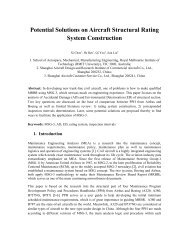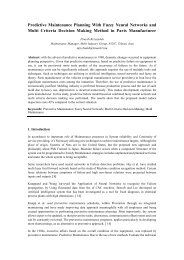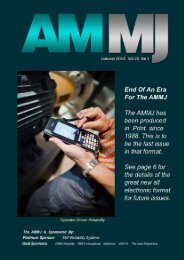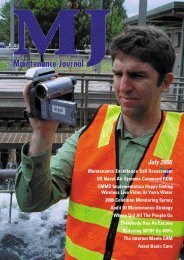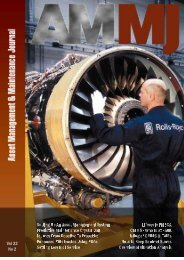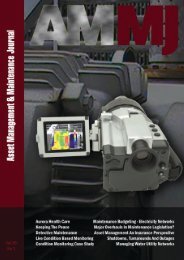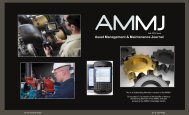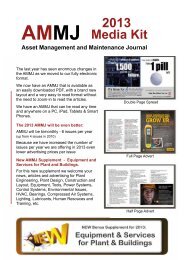July - AMMJ
July - AMMJ
July - AMMJ
Create successful ePaper yourself
Turn your PDF publications into a flip-book with our unique Google optimized e-Paper software.
Maintenance Decision Support Project<br />
At A Chemical Plant<br />
Ron Jenkins of Orica Australia,<br />
Murray Wiseman and Daming Lin of OMDEC Inc Canada<br />
Abstract - Does condition monitoring deliver the results you expect. Can we sharpen the saw and make a more<br />
informed reliability decision? This project investigated the use of a Maintenance Decision Support tool and how it<br />
may be used to improve reliability decisions based upon failure prediction. Data collection and manipulation proved<br />
to be the single most challenging issue. The accuracy with which failures are reported in the CMMS and the need to<br />
understand which failure modes actually occurred and whether they really failed or were suspended was shown to be<br />
of prime importance if reliability analysis was to succeed. The effort needed by the Reliability Engineer in performing<br />
reliability analysis pales in comparison to that required for the cleansing of the data and for its transformation into<br />
analyzable form. Once good data emerges from the anarchy of styles used within the CMMS, software makes light<br />
of the task of detailed reliability analysis that will enable good maintenance decisions.<br />
INTRODUCTION<br />
This paper provides an insight into the challenges faced by the Reliability Engineer before he can exploit Maintenance<br />
Decision Support software. The intent of this study is to apply such a tool (EXAKT© CBM Decision Optimization www.<br />
omdec.com/wiki) to critical magnetic pumps at the Orica Laverton North Chloralkali Plant in Australia. Conditioning<br />
Monitoring (CM) already existed. Nevertheless unexpected failures have occurred and the need to validate and<br />
improve on the CM process was paramount. Reliability based decisions may be assisted with specific types of data<br />
relating to equipment operation and maintenance. However, it is important to recognize that large volumes of CM data<br />
are no guarantee of good condition based maintenance decision models unless that data reflects the deterioration of<br />
failure modes that actually occur. How do we know what condition monitoring variables are significant? This project<br />
will attempt to use a software tool that analyses CMMS failure data in conjunction with condition monitoring data in<br />
order to identify those monitored variables that influence the probability of occurrence of the targeted failure modes.<br />
The methodology applies a Proportional Hazard Model (PHM)(see Ref 8) to determine not only which monitored<br />
variables are significant but also the precise probabilistic relationship between those variables and equipment failure.<br />
The main objective of this study is to understand the nature<br />
of the data required for this. The paper will discuss a data Tag<br />
Pump Description<br />
acquisition, cleansing and transformation philosophy for P12111A Catholyte Pump A<br />
condition monitoring programs that supports practical<br />
P12111B Catholyte Pump A<br />
decision making in maintenance.<br />
P13005 Caustic Evaporator Feed Pump<br />
SCOPE<br />
The study was limited to four pump sets over two years,<br />
an admittedly small sample. These pumps are all Iwaki<br />
magnetic pumps with Toshiba induction motors on caustic<br />
service as detailed in Table 1 opposite.<br />
RELIABILITY PREDICTION MODELS<br />
There are many reliability prediction software tools on the<br />
market. A basic search on the web reveals a number of<br />
vendors [1], [2], [3] for example. This project aims to trial<br />
one such program, EXAKT© because it is one of the few<br />
that confronts the challenge of achieving verifiable dayto-day<br />
decisions based upon the two principal available<br />
maintenance data sources: the CBM database(s) and the<br />
CMMS database.<br />
Reliability prediction is not new. One of the most widely<br />
recognised models was developed by Weibull in 1951<br />
[4]. He developed a failure analysis method that provided<br />
reliability predictions as well as the level of confidence with<br />
which those predictions may be applied.<br />
P13006 Intermediate Caustic Pump<br />
P12111AM Catholyte Pump A Motor<br />
P12111BM Catholyte Pump B Motor<br />
P13005M Caustic Evaporator Feed Pump Motor<br />
P13006M Intermediate Caustic Pump Motor<br />
Table 1<br />
EXAKT trial sample set<br />
Weibull Distribution - Three of its forms<br />
Weibull also showed that the shape parameter in his equation (above) relating reliability to age provides an indication<br />
of likely failure behavior. For a shape parameter of




